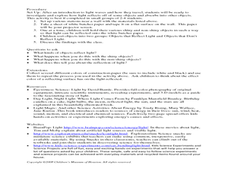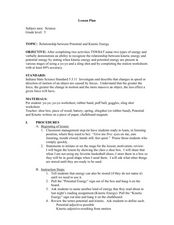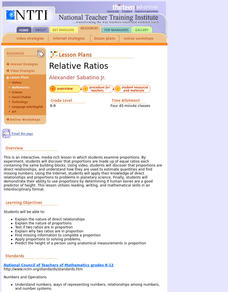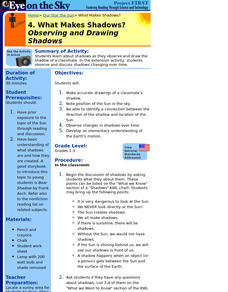Curated OER
Do Ten Again
In this counting to ten worksheet, learners solve four problems in which objects in a set are counted. Students then draw more objects to make ten in all. Learners then write the number 10.
Curated OER
Internet Measurement
Students become familiar with how to get information from the Internet. In this math and technology lesson plan, students measure objects on a measurement sheet found on a web site. They practice using a standard unit of measurement...
Curated OER
Momentum
In this momentum worksheet, learners solve 6 problems including finding the momentum of objects given their mass and velocity and applying the concepts of the conservation of momentum to solve for the speed and direction of moving objects.
Curated OER
Catapult Creations
Third graders design and build a catapult. In this lever lesson, 3rd graders collect a variety of lever type objects. Students build a catapult and launch marshmallows or crumpled paper and see who can hit the designated target.
Curated OER
Light Reflections
Young scholars explore light. In this physical science light lesson, students display objects on a projection screen and investigate how light absorbs, refracts, transmits and reflects. Young scholars discuss common features of...
Curated OER
What is the Attraction?
Second graders investigate the law of polarity. In this magnets lesson, 2nd graders discover how magnets are used in everyday life and which objects in our environment are magnetic. Students experiment with bar magnets and record...
Curated OER
Identity Boxes
Students create a "portrait" box that contains symbolic representations of their own identity. In this Lucas Samaras and Joseph Cornell art lesson, students discover ways that these two artists used symbols and objects to represent...
Curated OER
Relationship between Potential and Kinetic Energy
Fifth graders explore the relationship between potential energy and kinetic energy. In this energy lesson, 5th graders examine objects and describe potential and kinetic energy of the objects. Students complete two worksheets.
Curated OER
Cycles of Life in an Urban Habitat: Changes in Biodiversity
Second graders compare and contrast animate and inanimate objects. In this environmental science lesson, 2nd graders create simple food webs. They observe their environment and create a collage about it.
Curated OER
Momentum and Conservation of Momentum
In this momentum worksheet, learners calculate momentum from the mass and velocity of an object. Students learn about the Law of Conservation of Momentum. This worksheet has 8 matching, 6 fill in the blank, and 8 word problems.
Curated OER
Magnetic Energy
In this magnetic energy worksheet, students are given the formula to calculate the magnetic energy of an object. They use the formula to solve for the magnetic energy of the Earth, a geotail, the Sun, and a solar prominence given their...
Curated OER
Shapes Galore!
First graders explore two-dimensional shapes. Individually, children follow directions to draw shapes. Learners use shaving cream, geoboards, yarn, marshmallows, and toothpicks to create shapes. As a class, 1st graders brainstorm...
Curated OER
Relative Ratios
Students discover that proportions are made up of equal ratios each containing the same building blocks. They, using the Internet, apply their knowledge of direct relationships and proportions to problems in planetary science.
Curated OER
Image as a Metaphor
Students define "metaphor" and discuss examples of it in writing. They look carefully at a photograph by Dorothea Lange and discuss its relationship to the concept of metaphor. They write effectively about their own experience, picking...
Curated OER
Cloud and Weather Patterns
Fourth graders examine how weather patterns generally move from west to east across the United States, and how clouds are formed and are related to the water cycle. They view and discuss a PowerPoint presentation of the types of clouds,...
Curated OER
String Telephones and Musical Straws
Fourth graders investigate pitches of sound. In this physical science instructional activity, 4th graders participate in two activities that help them explore pitch--one activity has them working with string telephones and the...
Curated OER
Paper Towers
Students have the opportunity to use model-building as a way to help comprehend the forces and phenomena at work in the world around them. They describe gravity as a universal force that pulls everything toward the center of the earth....
Curated OER
Describing Motion
In this motion activity, students will use Newton's third law of motion to compare the force of objects on Earth with objects on Jupiter. This activity has 5 short answer questions.
Curated OER
About Life: The Photographs of Dorothea Lange Image as Metaphor
Young scholars define metaphor in both art and writing. In this metaphor lesson, students examine a photograph by Dorothea Lange and discuss the metaphor that is displayed in the picture. They write about an object that symbolizes a...
Curated OER
America on the Move
In this transportation worksheet, 3rd graders red short passages about different forms of transportation and how each evolved. students then answer 15 multiple choice and short answer questions with 1-2 questions following directly...
Curated OER
The Physics of the Planets: How 16th and 17th Century Physicist Helped Us Understand Our Solar System
Eighth graders draw the paths of the planets in the solar system. In this astronomy lesson, 8th graders calculate speed of objects using distance and time information. They research about the work of scientists in the 16th and 17th century.
Curated OER
Trips of Culture: The Statue of Liberty
Students take a pre-trip quiz about the Statue of Liberty and take a photo tour on the Internet. They then produce a grid drawing of an object and use a known measurement to estimate unknown measurements.
Curated OER
Line Segments and Dimensions
Fifth graders explore measurement. In this measurement lesson, 5th graders review fractions, simplifying and using rulers to practice measuring by inches and centimeters. Students are shown how to measure and given a...
Curated OER
What Makes Shadows? Observing and Drawing Shadows
Students make accurate drawings of a classmate's shadow. They note position of the sun in the sky. They identify a connection between the direction of the shadow and the location of the sun. They observe changes in shadows over time.
Other popular searches
- Indirect and Direct Objects
- Direct Objects Grammar
- Verbs and Direct Objects
- Spanish Direct Objects
- Direct Objects in English
- Language Arts Direct Objects
- Direct Objects English
- Direct Objects Verbs
- Direct Objects in Sentences
- German Direct Objects
- Compound Direct Objects
- Direct Objects Recognize























